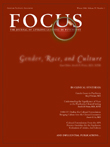Errata
In the Winter 2003 issue of FOCUS, on page 11, Table 3, which listed DSM-IV-TR criteria for a manic episode, included an additional item from another table. The correct criteria are as follows.
In the same issue, on page 35, one of the numbers in Figure 1 was mistranscribed from the original. Below is the corrected figure.
In the Spring 2003 issue, on pages 123–124, Quick Reference for Substance-Related Disorders; the sections, Substance Abuse Interview, Screening Interview for Diagnosis of Alcoholism, Alcoholic Drinking Patterns, and Detection of Drugs in Blood and Urine, should have included the credit line "From Jenkins SC, Tinsley JA, Van Loon JA. A Pocket Reference for Psychiatrists, Third Edition; American Psychiatric Press Inc, 2001, pp 223–227.”
| A. | A distinct period of abnormally and persistently elevated, expansive, or irritable mood, lasting at least 1 week (or any duration if hospitalization is necessary). |
| B. | During the period of mood disturbance, three (or more) of the following symptoms have persisted (four if the mood is only irritable) and have been present to a significant degree: |
| 1) inflated self-esteem or grandiosity | |
| 2) decreased need for sleep (e.g., feels rested after only 3 hours of sleep) | |
| 3) more talkative than usual or pressure to keep talking | |
| 4) flight of ideas or subjective experience that thoughts are racing | |
| 5) distractibility (i.e., attention too easily drawn to unimportant or irrelevant external stimuli) | |
| 6) increase in goal-directed activity (either socially, at work or school, or sexually) or psychomotor agitation | |
| 7) excessive involvement in pleasurable activities that have a high potential for painful consequences (e.g., engaging in unrestrained buying sprees, sexual indiscretions, or foolish business investments) | |
| C. | The symptoms do not meet criteria for a mixed episode. |
| D. | The mood disturbance is sufficiently severe to cause marked impairment in occupational functioning or in usual social activities or relationships with others, or to necessitate hospitalization to prevent harm to self or others, or there are psychotic features. |
| E. | The symptoms are not due to the direct physiological effects of a substance (e.g., a drug of abuse, a medication, or other treatment) or a general medical condition (e.g., hyperthyroidism). |
| Note: Manic-like episodes that are clearly caused by somatic antidepressant treatment (e.g., medication, electroconvulsive therapy, light therapy) should not count toward a diagnosis of bipolar I disorder. |

Figure 1. Mean Scores for Depression and Mania of Subjects With Bipolar Depression Who Received a Second Mood Stabilizer or Paroxetine in Addition to an Initial Mood Stabilizera
a Parenthetical numbers indicate numbers of remaining subjects, but the data points include imputed (last observation carried forward data on dropouts.



